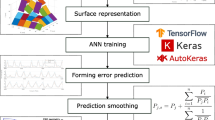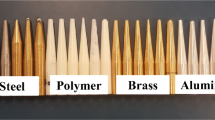Abstract
Die-less single point incremental forming (SPIF) is a highly versatile process that can form sheet metal blanks into desired geometries. A significant drawback of this process is the poor geometric accuracy largely attributed to material spring-back. This paper presents the use of Convolutional Neural Networks-Forming Prediction (CNN-FP) to predict this error, allowing users to better understand the expected distribution of geometric error prior to actual forming. The reported work differs from other published approaches in that a CNN was used as an automatic and flexible method for quantifying local geometries. The CNN-FP model was trained using a set of SPIF geometries with varying wall angles and corner radii. The performance of the trained model was validated using two SPIF geometries: one consisting of untrained wall angles and the other combining various features to create a complex geometry. The CNN-FP model achieved an RMSE (Root mean squared error) of 0.381 mm at 50 mm depth for the untrained wall angle. For the untrained complex geometry, the CNN-FP performance was found to be 0.391 mm at 30 mm depth. However, a significant deterioration was observed at 50 mm depth of the complex geometry, where the model’s prediction had an RMSE of 0.903 mm. While the model was shown to be efficacious in most of the validation tests, limitations in the breadth of training samples was attributed to the model’s degraded performance in some instances.














Similar content being viewed by others
Explore related subjects
Discover the latest articles, news and stories from top researchers in related subjects.Abbreviations
- ANN:
-
Artificial neural network
- CAD:
-
Computer-aided design
- CNN:
-
Convolutional neural networks
- CNN-FP:
-
Convolutional neural network-forming prediction
- DSIF:
-
Double-sided incremental forming
- FEA:
-
Finite element analysis
- LGM:
-
Local geometry matrix
- MARS:
-
Multivariate adaptive regression splines
- RMSE:
-
Root mean squared error
- SD:
-
Standard deviation
- STL:
-
Standard triangle language
- SPIF:
-
Single point incremental forming
References
Ai, Y., Jiang, P., Shao, X., Wang, C., Li, P., Mi, G., Liu, Y., & Liu, W. (2015). An optimization method for defects reduction in fiber laser keyhole welding. Applied Physics A, 122(1), 31. https://doi.org/10.1007/s00339-015-9555-8
Akrichi, S., Abbassi, A., Abid, S., & Ben Yahia, N. (2019). Roundness and positioning deviation prediction in single point incremental forming using deep learning approaches. Advances in Mechanical Engineering, 11(7), 1687814019864465. https://doi.org/10.1177/1687814019864465
Ambrogio, G., De Napoli, L., Filice, L., Gagliardi, F., & Muzzupappa, M. (2005). Application of incremental forming process for high customised medical product manufacturing. Journal of Materials Processing Technology, 162–163, 156–162. https://doi.org/10.1016/j.jmatprotec.2005.02.148
Amino, M., Mizoguchi, M., Terauchi, Y., & Maki, T. (2014). Current status of “Dieless” amino’s incremental forming. Procedia Engineering. https://doi.org/10.1016/j.proeng.2014.09.128
Bambach, M., & Hirt, G. (2007). Error analysis in explicit finite element analysis of incremental sheet forming. AIP Conference Proceedings, 908(1), 859–864. https://doi.org/10.1063/1.2740918
Behera, A. K., Verbert, J., Lauwers, B., & Duflou, J. R. (2013). Tool path compensation strategies for single point incremental sheet forming using multivariate adaptive regression splines. Computer-Aided Design, 45(3), 575–590. https://doi.org/10.1016/j.cad.2012.10.045
Eksteen, P., & Van der Merwe, A. (2012). Incremental sheet forming (ISF) in the manufacturing of titanium based plate implants in the bio-medical sector. In Proceedings of 42nd computers and industrial engineering (pp. 15–18).
Essa, K., & Hartley, P. (2011). An assessment of various process strategies for improving precision in single point incremental forming. International Journal of Material Forming, 4(4), 401–412. https://doi.org/10.1007/s12289-010-1004-9
Garg, A., Gao, L., Panda, B., & Mishra, S. (2017). A comprehensive study in quantification of response characteristics of incremental sheet forming process. The International Journal of Advanced Manufacturing Technology, 89(5–8), 1353–1365. https://doi.org/10.1007/s00170-016-9183-2
Gatea, S., Ou, H., & McCartney, G. (2016). Review on the influence of process parameters in incremental sheet forming. The International Journal of Advanced Manufacturing Technology, 87(1), 479–499. https://doi.org/10.1007/s00170-016-8426-6
Gupta, P., & Jeswiet, J. (2019). Manufacture of an aerospace component by single point incremental forming. Procedia Manufacturing, 29, 112–119. https://doi.org/10.1016/j.promfg.2019.02.113
Gupta, P., Szekeres, A., & Jeswiet, J. (2019). Design and development of an aerospace component with single-point incremental forming. The International Journal of Advanced Manufacturing Technology, 103(9), 3683–3702. https://doi.org/10.1007/s00170-019-03622-4
Guzmán, C. F., Yuan, S., Duchêne, L., Saavedra Flores, E. I., & Habraken, A. M. (2018). Damage prediction in single point incremental forming using an extended Gurson model. International Journal of Solids and Structures, 151, 45–56. https://doi.org/10.1016/j.ijsolstr.2017.04.013
Ham, M., & Jeswiet, J. (2006). Single point incremental forming and the forming criteria for AA3003. CIRP Annals, 55(1), 241–244. https://doi.org/10.1016/S0007-8506(07)60407-7
Isola, P., Zhu, J.-Y., Zhou, T., & Efros, A. (2017). Image-to-image translation with conditional adversarial. Networks. https://doi.org/10.1109/CVPR.2017.632
Khan, M. S., Coenen, F., Dixon, C., El-Salhi, S., Penalva, M., & Rivero, A. (2015). An intelligent process model: Predicting springback in single point incremental forming. The International Journal of Advanced Manufacturing Technology, 76(9), 2071–2082. https://doi.org/10.1007/s00170-014-6431-1
Kim, Y. H., & Park, J. J. (2002). Effect of process parameters on formability in incremental forming of sheet metal. Journal of Materials Processing Technology, 130–131, 42–46. https://doi.org/10.1016/S0924-0136(02)00788-4
Krizhevsky, A., Sutskever, I., & Hinton, G. E. (2012). Imagenet classification with deep convolutional neural networks. Advances in Neural Information Processing Systems, 25, 1097–1105. https://doi.org/10.1145/3065386
Kulkarni, S., & Mocko, G. (2020). A finite element simulation model of convective heat-assisted single-point incremental forming of thermoplastics. The International Journal of Advanced Manufacturing Technology, 111, 1–13. https://doi.org/10.1007/s00170-020-06311-9
Lee, S., Nguyen, D., Kim, N., Yang, S., & Kim, Y. (2011). Application of incremental sheet metal forming for automotive body-in-white manufacturing. Transactions of Materials Processing, 20(4), 279–283. https://doi.org/10.5228/KSTP.2011.20.4.279
Li, Y., Chen, X., Liu, Z., Sun, J., Li, F., Li, J., & Zhao, G. (2017). A review on the recent development of incremental sheet-forming process. The International Journal of Advanced Manufacturing Technology, 92(5), 2439–2462. https://doi.org/10.1007/s00170-017-0251-z
Möllensiep, D., Kulessa, P., Thyssen, L., & Kuhlenkötter, B. (2020). Regression-based compensation of part inaccuracies in incremental sheet forming at elevated temperatures. The International Journal of Advanced Manufacturing Technology, 109(7), 1917–1928. https://doi.org/10.1007/s00170-020-05625-y
Möller, T., & Trumbore, B. (1997). Fast, minimum storage ray-triangle intersection. Journal of Graphics Tools, 2(1), 21–28. https://doi.org/10.1080/10867651.1997.10487468
Moser, N., Pritchet, D., Ren, H., Ehmann, K. F., & Cao, J. (2016). An efficient and general finite element model for double-sided incremental forming. Journal of Manufacturing Science and Engineering. https://doi.org/10.1115/1.4033483
Panthi, S. K., Ramakrishnan, N., Ahmed, M., Singh, S. S., & Goel, M. D. (2010). Finite element analysis of sheet metal bending process to predict the springback. Materials & Design, 31(2), 657–662. https://doi.org/10.1016/j.matdes.2009.08.022
Qi, Q., & Tao, F. (2018). Digital twin and big data towards smart manufacturing and industry 4.0: 360 degree comparison. IEEE Access, 6, 3585–3593. https://doi.org/10.1109/ACCESS.2018.2793265
Zhang, Z., Zhang, H., Shi, Y., Moser, N., Ren, H., Ehmann, K. F., & Cao, J. (2016). Springback reduction by annealing for incremental sheet forming. Procedia Manufacturing, 5, 696–706. https://doi.org/10.1016/j.promfg.2016.08.057
Funding
Funding was provided by a*star (Grant No. R-265-000-636-305).
Author information
Authors and Affiliations
Corresponding author
Additional information
Publisher's Note
Springer Nature remains neutral with regard to jurisdictional claims in published maps and institutional affiliations.
Rights and permissions
About this article
Cite this article
Low, D.W.W., Chaudhari, A., Kumar, D. et al. Convolutional neural networks for prediction of geometrical errors in incremental sheet metal forming. J Intell Manuf 34, 2373–2386 (2023). https://doi.org/10.1007/s10845-022-01932-1
Received:
Accepted:
Published:
Issue Date:
DOI: https://doi.org/10.1007/s10845-022-01932-1




